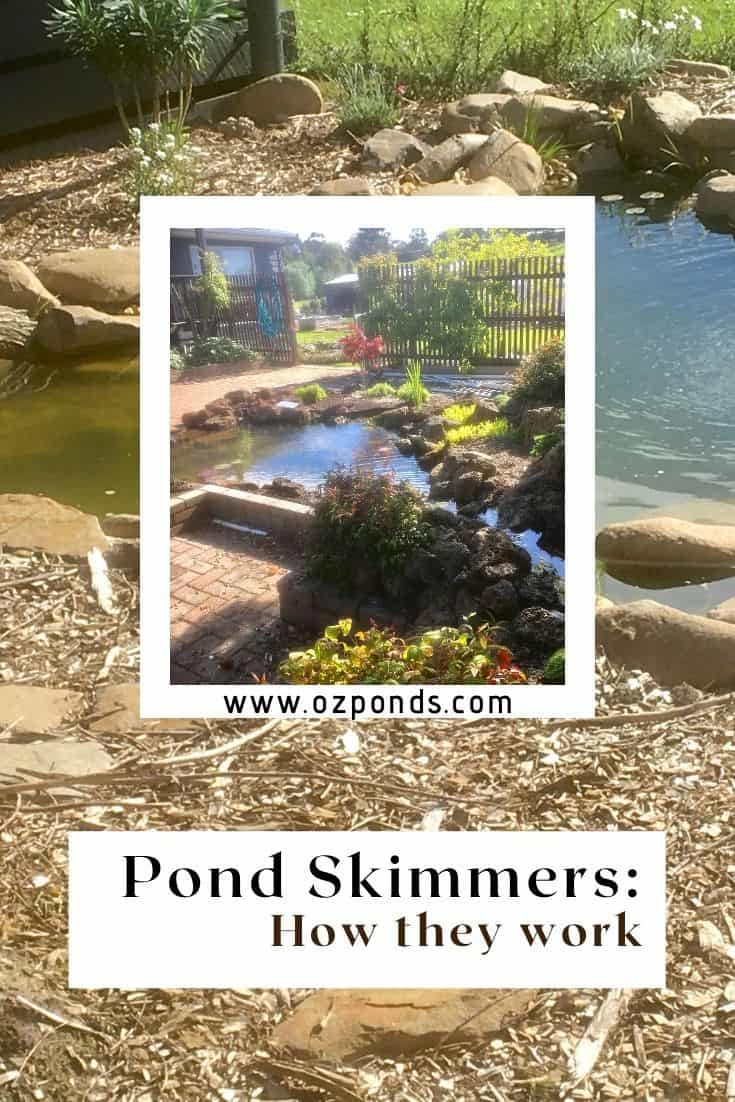A pond skimmers main function is to remove organic materials from the pond before they begin to decay.
When organic materials like leaves, break down, they release nutrients and gasses into the pond water.
Preventing these gasses and nutrients to build up will reduce pond maintenance and enhance overall water quality.
Because a skimmer is removing physical objects from the pond it is referred to as a mechanical filter.
Without a pond skimmer these materials need to be removed manually. A good pond skimmer allows a pond owner to spend more time enjoying their pond and less time cleaning their pond!
A pond skimmer provides excellent mechanical filtration but a well designed pond should also incorporate biological filtration.
Biological filtration is the use of beneficial bacteria’s to purify the pond water. To fully understand the incredibly important role that bacteria plays in a healthy pond read my article on the nitrogen cycle.
There are many ways to incorporate biological filtration, but as far as mechanical filtration goes its hard to find anything better than a pond skimmer!
How does a pond skimmer work?
A pond skimmer works by creating tension on the water.
This “tension” draws water into the pond skimmer.
Within the skimmer is a basket and/or filter sponge. All the debris gets pulled into the basket and smaller particles get trapped in the sponge.
Once collected in the basket the leaves and other debris can easily be emptied.
From time to time the sponge will need to be rinse off and cleaned to prevent it clogging up.
If the basket or sponge gets to clogged with debris it will greatly reduce the flow into the pump. This can affect its lifespan.
How often the basket needs to be emptied depends entirely on the location of the pond and the season.
For obvious reasons a pond located under large deciduous trees will need its skimmer basket emptied more frequently, than a pond located in the open.
The “water tension” is created by the pond pump and a weir. A pond skimmer needs a submersible pond pump located in the unit, to suck water in.
The weir provides resistance so that just the right amount of water is pulled into the skimmer.
This thin layer of water being pulled from the pond, over the weir, into the skimmer is what creates the “tension”.
The tension creates a current or a pulling effect. This leads to anything, floating or suspended in the water, being sucked into the pond skimmer.
Incorporating filter pads within the skimmer will help collect those fine solids that slip through the skimmer basket. Things like fish waste or uneaten fish food.
Again, the more organic material that can be removed from the pond the better your water quality will be!
Do I need a skimmer?
No. You don’t need a pond skimmer, but most ponds should have one.
Small ponds can get away without having a skimmer, just remember you will need to clean out the accumulation of organic muck that will build up over time.
If you leave muck it will break down and release nutrients into the water.
Nutrients in most instances won’t affect fish health, however they will turn your water green as single cell algae forms to consume the nutrients.
There are some specially developed enzymes (amazon link) that will eat away at the muck and can be beneficial to a pond.
The easiest way to remove debris is to net it out on a regular basis. Without a skimmer you’re probably still looking at requiring one or two major clean outs a year.
The easiest way to conduct a clean out is to drain the water and then physically remove the waste. Remember to keep the pond water, it’s already fish safe and has the appropriate water parameters.
Using a pond vac or dirty water sump pump are my preferred methods of cleaning a pond without a skimmer.
Should I have pebbles in my pond if I don’t have a skimmer?
Probably not.
I love Pebbles in a pond!
They provide breeding grounds for beneficial bacteria, micro organisms and make the pond look more natural.
But without a skimmer the bottom of the pond will become quite dirty with leaves and other debris.
It’s just easier to physically remove the muck without pebbles being in the way.
To naturalise the pond consider using larger easier to remove rocks and incorporate plenty of potted water plants.
If they are in pots, they can easily be moved about during a clean out. The other benefit of the plants is their ability to draw nutrients from the water.
Plenty of plants consuming nutrients is a great way to keep algae at bay!
Here is a video showing one of my goldfish ponds. It doesn’t have a skimmer but it has a nice sized bog filter.
What size pond skimmer do I need?
All pond skimmers will tell you how much surface area the can skim and what sized pumps they can accommodate.
So these are the two things you’ll need to look at when choosing an appropriate skimmer.
Calculating the surface area of your pond is super easy. You just multiply the length by the width (L x W= surface area).
You also need to know how much water your pump is pumping per hour.
Pond skimmers will specify the flow rates they can handle. Ensure the flow rate of your pump does not exceed the pond skimmers specifications.
If your pump is oversized for the skimmer you run the risk of pumping the skimmer box dry.
Can I build a diy pond skimmer?
Of course! The original pond skimmers were made out of repurposed garbage bins.
I’ve built a few homemade skimmers.
One I used a large 220 litre plastic drum.
The other i used a simple 20 litre bucket.
So far its my favourite and that includes expensive units I’ve purchased. It only cost $5 for the bucket and $10 for the sponge.
Much cheaper than the hundreds you’ll spend on a store bought skimmer.
The skimmer needs to be large enough to hold the pump.
The water need to be quite shallow to create the tension. Also funnel the water in through a small opening.
In the video you’ll see I used large rocks to channel the water into the skimmer bucket.
I used a small piece of pond liner to create a shallow area that forces the water up and over into the bucket.
That small piece of liner acts as the weir and creates the surface tension.
One of the things i like most about this skimmer is my small fish can swim in and out of the area without getting trapped.
In my aquascape skimmer i needed to remove the weir door to stop the fish from getting trapped.
Now they can swim in and out but the skimming effect has been reduced.
Different types of pond skimmers.
There’s 3 types of pond skimmers: those that are fixed to the side of the pond and are a permanent fixture, those that can be hooked up to a pump and sit in the pond itself and those that float around the pond.
Fixed skimmer
The most commonly used skimmer is the one fixed to the side of the pond. These are usually installed during the pond build, but can be retrofitted easily enough if required.
The benefits of these skimmers are:
- They blend seamlessly into the pond landscape.
- They are easily accessed, making maintenance simple.
- Generally very durable. Have large baskets that reduces the frequency of checking the skimmer.
Cons:
- They aren’t movable. So if they are positioned incorrectly you will need to use pond jets or extra pumps to direct the debris to the skimmer.
- Water level needs to be monitored. If the water drops below the skimmer water cannot enter the pump. This can burn the pump out. The best solution is to install an auto top up.
Skimmer that sits within the pond
These skimmers can be hooked up to your existing pump or a secondary pump.
The main benefits of these skimmers are:
- Very easy to add to an existing pond.
- Great for preformed, ridged liner ponds where cutting a hole for a skimmer box isn’t an option.
- Ability to be removed or repositioned during different times of year.
Cons:
- Collection point is relatively small, so requires frequent checking.
- Sitting within the pond makes access harder.
- Harder to blend into the pond landscape.
Floating pond skimmer
Some of these skimmers require you to supply the pump, while other brands have the pump built in. Either way they work by floating around the pond collecting leaves and other debris.
Benefits of floating skimmers:
- Can easily be added to any pond.
- Their mobility allows them to very effectively skim the pond of debris.
- No cutting of pond liner required.
- The water level of the pond can fluctuate and not effect the function of the skimmer.
Cons:
- Generally have small baskets, therefore requiring more frequent emptying.
- A basket of debris floating around the pond isn’t really aesthetically pleasing.
- Can easily get pushed into a corner due to wind, making them less effective.
What’s the best pond skimmer you can buy?
For me i prefer to build my own skimmer. Of course thats not for everyone.
So if you want to buy a pond skimmer i think the the best options are the fixed units.
They are very easy to blend into the landscape and easy to install. Even on an existing pond.
I personally like the aquascape range of pond skimmers. There are 3 main models to choose from. They are very durable and come with a limited lifetime warranty.
The aquascape signature series 200 (amazon link). This skimmer is great for ponds up to 200 square feet (60m2) and can handle pumps up to 3000 GPH (11,350 Litres/per hour)
Signature series 400 (amazon link). For ponds up to 400 square feet (120m2) and handles pumps up to 4000 GPH (15,100 Litres/per hour).
And the signature series 1000 (amazon link). For ponds up to 1000 square feet (305m2) and handless pumps up to 10,000 GPH (37,800 Litres/per hour).
On larger ponds simply add additional skimmers.
If a fixed unit skimmer is out of the question due to a ridged or concrete lined pond, i think the floating skimmers are the way to go.
I like the OASE floating skimmers (amazon link) as the brand is well respected. This skimmer will work on ponds up to 270 square feet (82m2) and has a built in 580 GPH (2195 litres/per hour) pump, with built in aerator.
It has a good sized basket at 55 cubic inches (140cm2) and only consumes 40 watts of energy. The only down side is it needs a minimum of 16″ (41cm) of pond depth to operate.
Subscribe
I often receive special offers and discounts from pond product suppliers and distributors. I love passing these savings onto my readers.
If you would like to receive these offers direct to your inbox, sign up using the button below.

